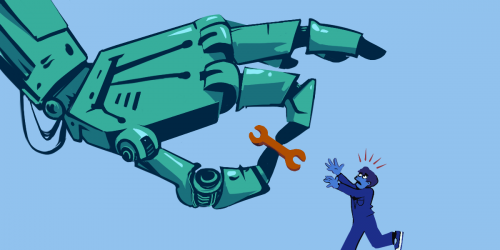The multi-pronged attempt by state Attorneys General, the Department of Justice, and the Federal Trade Commission to find Google and Facebook liable for violating antitrust law may result in breaking up these giant companies. But in order for any of this to cause lasting change, we need to look to the not-so-recent past.
In the world of antitrust, the calls to “break up” Big Tech companies translate to the fairly standard remedy of “structural separation,” where companies are barred from selling services and competing with the buyers of those services (for example, rail companies have been forced to stop selling freight services that compete with their own customers). It has been done before as part of the fight against communication monopolies. However, history shows us that the real work is not just breaking up companies, but following through afterward.
In order to make sure that the Internet becomes a space for innovation and competition, there has to be a vision of an ideal ecosystem. When we look back at the United States’ previous move from telecom monopoly into what can best be described as “regulated competition,” we can learn a lot of lessons—good and bad—about what can be done post-breakup.
The AT&T of Yore and the Big Tech of Today
Cast your mind back, back to when AT&T was a giant corporation. No, further back. When AT&T was the world’s largest corporation and the telephone monopoly. In the 1970s, AT&T resembled Big Tech companies in scale, significance, and influence.
AT&T grew by relentlessly gobbling up rival companies and eventually struck a deal with the government to make its monopolization legal in exchange for universal service (known as the Kingsbury Commitment). As a monopolist, AT&T's unilateral decisions dictated the way people communicated. The company exerted extraordinary influence over public debate and used its influence to argue that its monopoly was in the public interest. Its final antitrust battle was a quagmire that spanned two political administrations, and despite this, its political power was so great that it was able to get the Department of Defense to claim its monopoly was vital to national security.
Today, Big Tech is reenacting the battle of the AT&T of yore. Facebook CEO Mark Zuckerberg assertion that his company’s dominance is the only means to compete with China is a repeat of AT&T’s attempt to use national security to bypass competition concerns. Similarly, Facebook's recent change of heart on whether Section 230 of the Communications Decency Act should be gutted is an effort to appease policymakers looking to scrutinize the company's dominance. Not coincidentally, Section 230 is the lifeblood of every would-be competitor to Facebook. In trading 230 in for policy concessions, Facebook both escapes a breakup and salts the earth against the growth of any new competitors to become the regulated monopoly that remains.
Google is a modern AT&T, too. Google acquired its way to dominance by purchasing a multitude of companies to extend its vertical reach over the years. Mergers and acquisitions were key to AT&T's monopoly strategy. That's why the government then sought to break up the company – and that's why the US government today is proposing breakups for Google. Now, with AT&T, there were clear geographic lines on which the company could be broken into smaller regional companies. It's different for Google and Facebook: those lines will have to be drawn along different parts of the companies "stack," such as advertising and platforms.
When the US Department of Justice broke up AT&T, it traded one national monopoly for a set of regional monopolies. Over time Congress learned that it wasn't enough. Likewise, breakups for Google and Facebook will only be step one.
Without a Broader Vision, Big Tech Will Be the Humpty Dumpty That Put Himself Back Together Again
Supporters of structural separation for Big Tech need to learn the lessons of the past. Our forebears got it right initially with telecom but then failed to sustain a consistent vision of competition eventually allowing dozens of companies to consolidate into a mix of regional monopolies or super dominant national companies.
When originally passed, the 1996 telecom law Congress passed to follow the AT&T breakup enabled the creation of the Competitive Local Exchange Carrier (aka CLEC) industry. These were smaller companies that already existed but had been severely hamstrung by the local monopolies. Their reach was severely limited because there was no federal competition law.
The 1996 Act lowered the start-up costs for new phone companies: they wouldn't have to build an entire network from scratch. The Act forced the Baby Bells (the regional parts of the original AT&T monopoly) to share their "essential facilities" with these new competitors at a fair price, opening the market to much smaller players with much less capital.
But the incumbent monopolies still had friends in statehouses and Congress. By 2001, federal and state governments began adopting a new theory of competition in communications: "deregulated competition"—which whittled away the facilities sharing rules and rules banning the broken up parts of AT&T from merging with one another again (as well as cable and wireless companies). If the purpose of this untested, unproven approach was to promote competition, then clearly it was a failure. A majority of Americans today have only one choice for high-speed broadband access that meets 21st century needs. There has been no serious reckoning for "deregulated competition" and it remains the heart of telecom policy despite nearly every prediction of the benefits of "deregulated competition" having been proven wrong. This only happened because policymakers and the public forgot how they received competition in telecom in the first place and allowed the unwinding that remains with us still today.
Steve Coll, author of The Deal of the Century: The Breakup of AT&T, predicted this problem shortly after the AT&T's breakup:
It is quite possible - some would argue it is more than likely - that the final landscape of the Bell System breakup will include a bankrupted MCI and an AT&T returned to its original state as a regulated, albeit smaller and less effective, telephone monopoly. The source of this specter lies not in anyone's crystal ball but in the history of U.S. v. AT&T. Precious little in that history - the birth of MCI, the development of phone industry competition, the filing of the Justice lawsuit, the prolonged inaction of Congress, the aborted compromise deals between Justice and AT&T, the Reagan administration's tortured passivity, the final inter-intra settlement itself - was the product of a single coherent philosophy, or a genuine, reasoned consensus, or a farsighted public policy strategy.
A Post-Breakup Internet Tech Vision: Decentralization, Empowerment of Disruptive Innovation, and Consumer Protection
Anyone thinking about Big Tech breakups needs to learn the lesson of AT&T. Breakups are just step one. Before we take that step, we need to know what steps we'll take next. We need a plan for post-break-up regulated competition, or we'll squander years and years of antitrust courtroom battles, only to see the fragments of the companies reform into new, unstoppable juggernauts. We need a common narrative about where competition comes from and how we sustain it.
Like phone companies, internet platforms have “network effects”: to compete with them, a new company needs access, not the company's "ecosystem" – the cluster of products and services monopolists weave around themselves to lock in users, squeeze suppliers, and fend off competitors. In '96, we forced regional monopolies to share their facilities and thousands of local ISPs sprung up across the country, almost overnight. Creating a durable competitive threat to tech monopolists means finding similar measures to promote a flourishing, pluralistic, diverse Internet.
We've always said that tech industry competition is a multifaceted project that calls for multiple laws and careful regulation. Changes to antitrust law, intellectual property law, intermediary liability, and consumer privacy legislation all play critical and integral parts in a more competitive future. Strike the wrong balance and you drain away the Internet's capacity for putting power in the hands of people and communities. Get any of the policies wrong and you risk strangling a hundred future Googles and Facebooks in their cradles—companies whose destiny is to grow for a time but to eventually be replaced by new upstarts better suited for the unforeseeable circumstances of the future.
Here are two examples of policies that are every bit as important as breakups for creating and maintaining a competitive digital world:
- A private right of action that ties consumer privacy rights to the individual and ensures all marketplace participants are responsible for protecting individual user privacy. This legal protection will increase consumer willingness to switch products as what they use will not impact how they are protected. Conversely, the loss of privacy has been shown through studies to reduce consumer willingness to try new products, particularly when they impact sensitive uses such as finance and health.
- Incumbents must be denied the means of suing competitors as a means to retain their dominance. That's why laws like the Computer Fraud and Abuse Act (which Facebook used to sue a competitor out of existence and still leverages against innovation today) have to be significantly narrowed in scope.
The Internet once stood for a world where people with good ideas and a little know-how could change the world, attracting millions of users and spawning dozens of competitors. That was the Net's lifecycle of competition. We can get that future back, but only if we commit to a shared and durable vision of competition. It's fine to talk about breaking up Big Tech, but the hard part starts after the companies are split up. Now is the time to start asking what competition should look like, or we'll get dragged back to our current future before we get started down the road to a better one.











